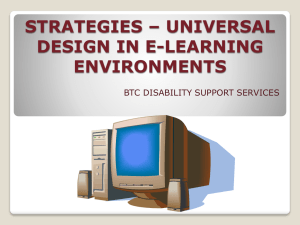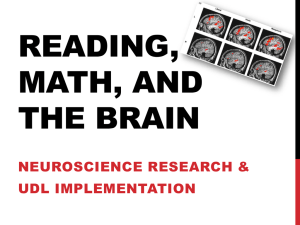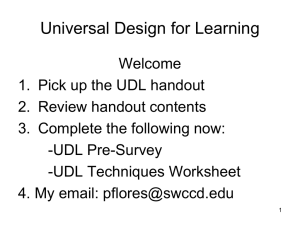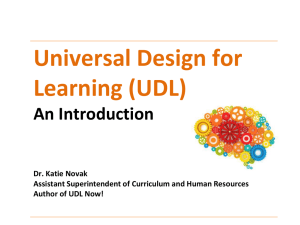Session PowerPoint - National Center on Accessible Instructional
advertisement
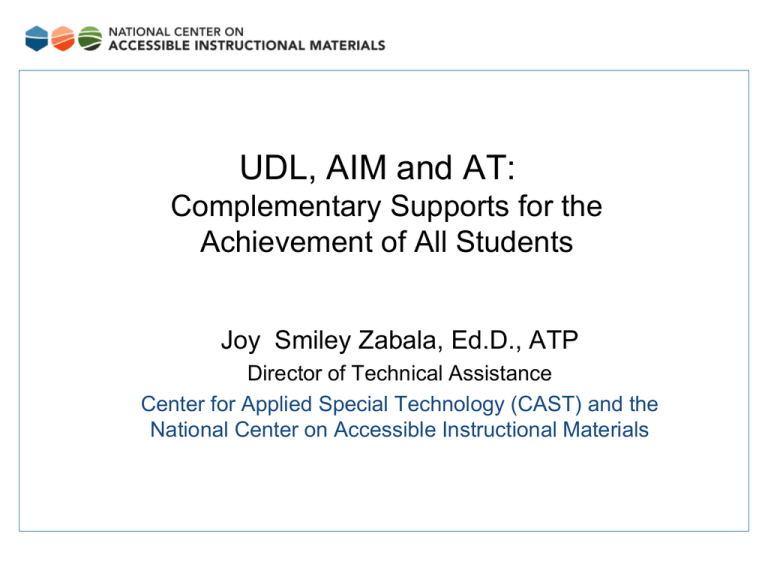
UDL, AIM and AT: Complementary Supports for the Achievement of All Students Joy Smiley Zabala, Ed.D., ATP Director of Technical Assistance Center for Applied Special Technology (CAST) and the National Center on Accessible Instructional Materials Who Are We? ADMINISTRATORS & TEACHERS TECHNOLOGY LEADERS FAMILIES & PERSONAL SUPPORT STUDENT MEDIA DESIGNERS, DEVELOPERS & DISTRIBUTORS OTHER AGENCIES & ORGANIZATIONS About this Session In this session, we will discuss myths and realities related to: •The meaning and purposes of UDL, AT, and AIM •The ways that UDL, AT and AIM work together as complementary supports for the participation and achievement of ALL students •Online resources for further exploration of UDL, AT and AIM The common goal of all educational activities must be increasing achievement and producing outcomes that enable competition and cooperation in a global world. The Vision Students with highly variable abilities, needs, and experiences in various educational environments will use a plethora of tools and strategies 1) to master tasks that lead to educational achievement and 2) to demonstrate achievement! Dispelling some common myths about Universal Design for Learning Assistive Technology and Accessible Instructional Materials UDL, AT, and AIM are special education technology initiatives. #1 UDL and AT and AIM • UDL, AT and AIM are complementary supports for the achievement of all students. • UDL principles help educators proactively design goals, methods, materials and assessment that address the full range of student variability in today’s learning environments. • AT ensures that individual students have the tools they need to participate and learn in whatever environments they find themselves. • AIM ensure access to the content in educational materials used by all students Universal Design for Learning Is a flexible framework proactively provides flexibility in the ways information is presented, the ways students respond or demonstrate knowledge and skills and the ways students are engaged Assumes and plans for diverse student strengths and needs Maintains challenge and high achievement expectations for all students Reduces unnecessary barriers by providing appropriate scaffolds, accommodations and supports Places emphasis on the use of digital technology and other strategies and materials to support all learners Principles and Components of a UDL Curriculum Multiple means of representation, to give learners various ways of acquiring information and knowledge Multiple means of expression, to provide learners alternatives for demonstrating what they know Multiple means of engagement, to tap into learners' interests, offer appropriate challenges, and increase motivation. Universally Designed Technologies • Technologies that are deigned and developed to be directly usable (without the need for adaptation or assistive technology) • Technologies that are designed and developed in ways that can be made usable with assistive technologies • Technologies that typically include lots of options that can be readily manipulated to meet the needs of a variety of users 12 Assistive Technology Is an individualized system of no tech, low tech, and high tech tools, strategies, and services that match a student’s needs, abilities, environments and tasks Is related to function, rather than to a specific disability category Includes a broad range of possible devices and services Enhances capabilities and lowers barriers to achievement May be applicable to all disability groups and in all phases of education, rehabilitation, and life May be needed long-term and across environments Must be person-centered, task-focused and environmentally useful to be effective Accessible Instructional Materials Are required for some but may be needed by many Must be provided by SEAs and LEAs in a timely manner to students who are unable to use print-based materials because of blindness or other disability (IDEA, Section 300.172) Include materials designed or enhanced to be usable across the widest possible range of student variability regardless of format (print, digital, graphical, audio, video) Includes both “born print” content that requires retrofitting and “born digital” content that is difficult to retrofit if not accessible from the start Both the content and the technologies used to deliver the content, including hardware and software, must be accessible to and usable by the individual student. Specialized Formats of Print-Based Educational Materials • Typically require retrofitting into specialized formats that presents the same content in a different way. • Typically require technology for delivery and/or interaction Students Who May Need AIM Students who are blind or have other disabilities that impede the effective use of “typical” instructional materials used across the curriculum Served under IDEA and meets copyright criteria for specialized formats Not served under IDEA. Not meeting copyright criteria. Students without identified disabilities who cannot make effective use of “typical” instructional materials Struggling readers. Students lacking English proficiency, etc. Students who simply prefer options for different task If you “have” UDL, you don’t need AT #2 UDL and AT Purpose of UDL: To proactively support access to and progress in the general curriculum for students with and without identified disabilities Purpose of AT: To increase, improve or maintain the functional capabilities of individual students with disabilities Educational outcome for both: Increased educational participation and achievement If it’s “regular stuff” it’s not AT #3 What makes a “thing” AT is why it is needed and how its used… not about where you get it! AT is ANY ITEM that is used to increase, improve or maintain the functional capabilities of an individual with disabilities. No matter what “it” is, where “it” comes from or who pays for “it”, it’s AT if… It is used to improve increase or maintain the functional capabilities of an individual with disabilities it is needed to assist someone with a disability in doing something that would be difficult or impossible to do without “it” AT is related to function and the least complex tool that lowers barriers should be a first consideration • Reading • Seating/Positioning • Written Expression • Hearing • Math • Seeing • Problem-solving • Self-Care • Communication • Recreation • Daily organization • Mobility • Behavior • Specific task-related skills Accessible Instructional Materials are Assistive Technology #4 AIM and Technology are two sides of the same coin • AIM is the Content • Technology is the delivery system AIM is about need, not about where you get it! There are multiple source for AIM but all sources cannot be used for the acquisition of materials for all students (See Acquisition section of the AIM Navigator) If a student cannot use current instructional materials effectively, AIM should be explored (see the AIM Navigator) If AIM in needed, it must be provided to some and, logically, should be provided to each Increased availability of accessible materials for purchase will lower many barriers In a world going digital, this does not seem to be a problem, right? WRONG! Many digital materials are NOT accessible! The PALM Initiative at the AIM Center • Accessible: Usable by everyone right from the start • Learning: Materials are designed with pedagogy in mind or are flexible enough that one can build in learning supports • Materials: Anything used in classrooms If we only had a SuperAlphaNumerator everything would be fine! #5 “The Right Tool” There are many, many “right” tools, but none are “right” for every student or every task Even the “right” technology does not “make” an expert learner For many students technology enhances engagement in teaching/learning processes For some students technology increases participation and independence Technology greatly enhances the ability of educators plan for and provide flexibility across educational practices Effective USE of technology typically includes instruction, training, scaffolds and, for some, accommodation/modifications and support services A good teacher can succeed with every student without additional supports! #6 Shared Responsibility for Student Achievement GOALS: Does the curriculum include firm goals with flexible means for achievement? METHODS: Do educators have learning opportunities needed build the knowledge and skills needed to address variability in their teaching practices? MATERIALS: Are materials acquired at the system level accessible and usable across the broadest possible range of student variability? ASSESSSMENT: Are people at all level of the organization grappling with the challenges of meaningful formative and summative assessment? SUPPORTS: Are more intensive supports and services provided in a timely manner when needed? If we talk about UDL, AT and AIM long enough people will be able to implement them in the classroom and at home. #7 Some Supports for UDL Visit the UDL Center Web Site http://udlcenter.org Peruse the UDL Guidelines and dig deeply into them View examples and try out ideas Work through the UDL Online Modules Join in UDL conversations with others grappling with the same challenges and opportunities Find out about the UDL Task Force and the UDL Implementation Network Some Supports for AT Assistive Technology Industry Association: http://atia.org Closing the Gap: http://closingthegap.com Google “Assistive Technology” Join the QIAT List in AT conversations with over 2000 others at http://www.qiat.org Follow smart people on the web, e.g. Karen Janowski’s blog at http:/teachingeverystudent.blogspot.com/ Join the Technology and Media Division of CEC http://www.tamcec.org/ Some Supports for AIM Explore the AIM Center website http://aim.cast.org Find information for AIM in Your State http://aim.cast.org/learn/policy/state/nimas_nimac_contacts Check out the AIM Navigator http://aim.cast.org/navigator/page/ Learn about the PALM Initiative and share the information http://aim.cast.org/learn/practice/palm Check out Bookshare and Learning Ally http://bookshare.org http://learningally.org What’s Important? Make it so! Student Environment Tasks Tools And… if you want to know more about the SETT Framework and SETT Scaffolds • • • • • Consideration Data Gathering Tools Selection Implementation Evaluation of Effectiveness http://www.joyzabala.com ”Our challenge is not to educate the children we used to have or want to have, but to educate the children who come to the schoolhouse door.” H. G. Wells
